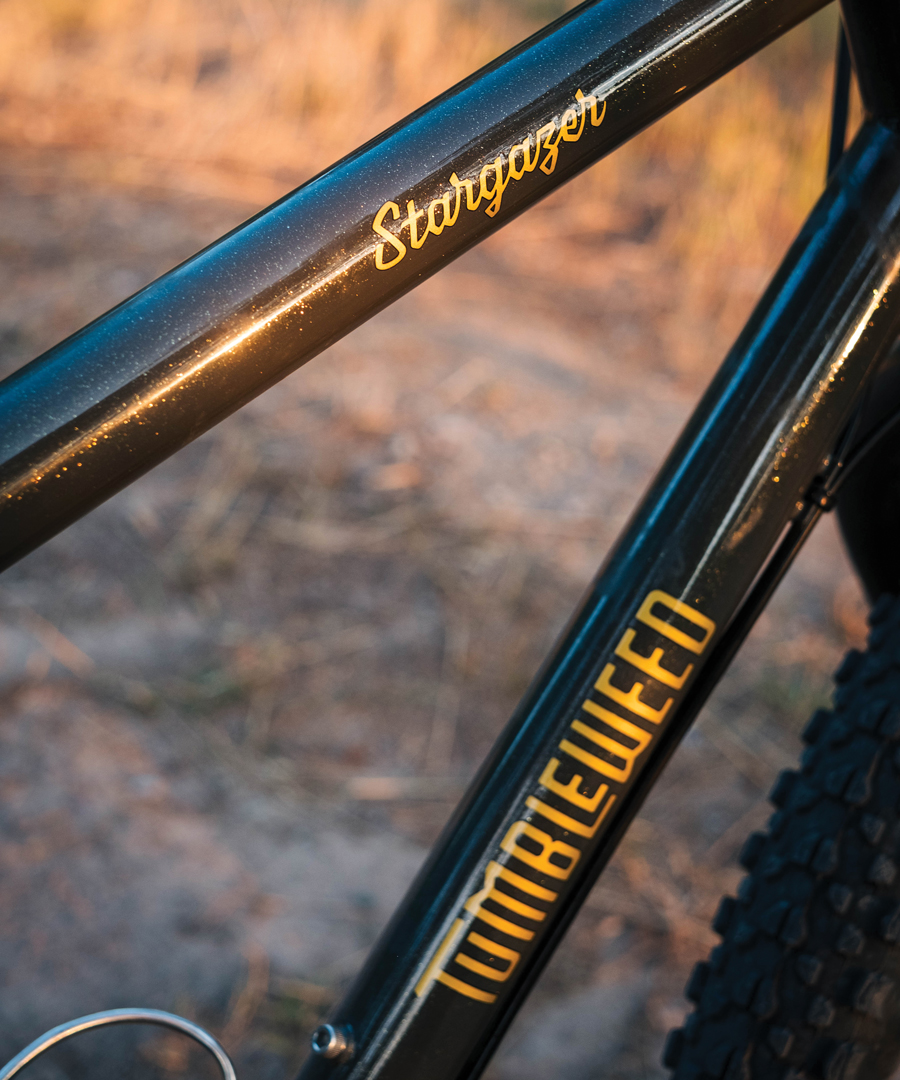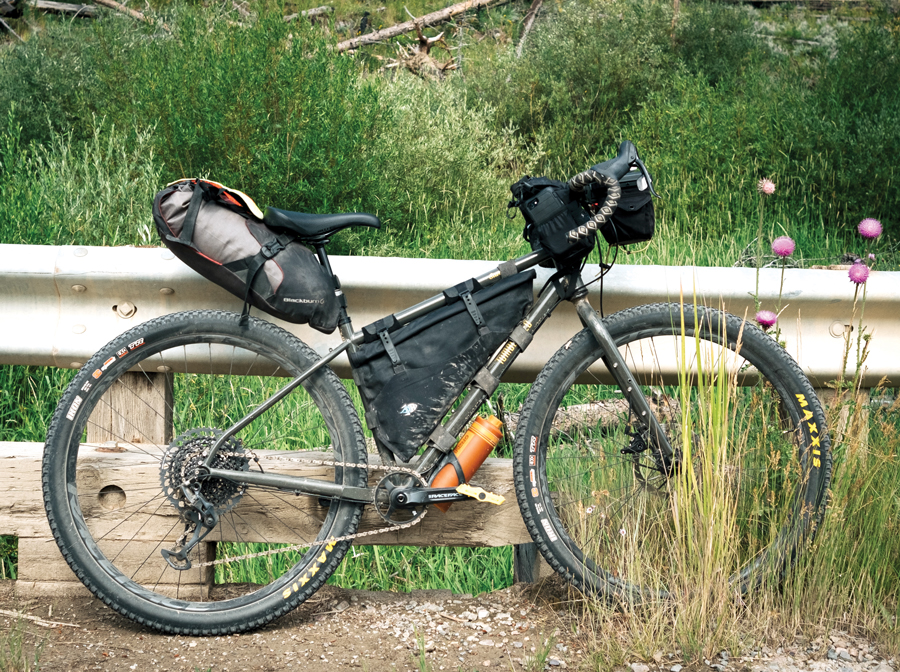Road Test: Tumbleweed Stargazer
Immediately after unboxing and building up the Tumbleweed Stargazer, I took it out for a neighborhood shakedown to make sure everything was tight and straight. I had first-date jitters and … I crashed. It didn’t even make sense: I was going ever so slightly uphill very slowly on pavement. No, there were no stars out to divert my attention. It was 5:00 pm in the middle of summer in Montana, when the sun doesn’t set until five hours later. But if there had been stars to gaze at … well, I would have loved to make that corny joke.
My distraction, unfortunately, can’t be blamed on an errant driver or a gaggle of baby ducks crossing the road — my eyes were too busy looking all around me, everywhere but straight ahead, trying to take in the views. In time, I found that pretty much sums up the ethos of the Stargazer. Not the being-dangerously-distracted-from-the-road part, but rather the soaking-in-your-surroundings part. In my extended time with the bike, I kept noting how the geometry is so upright that it almost feels like running instead of pedaling. The Stargazer essentially feels like a snug, overstuffed armchair that you can sink into to watch the world unfold ahead.
Fun fact: during a long stint of bikepacking in 2017 during which I had no permanent address, a close friend christened me with the trail name Tumbleweed. It’s only natural that I’ve been crushing hard on Tumbleweed as a brand for those six years since the release of their flagship bike, the Prospector, Tumbleweed’s all-rounder expedition bike for world travels — built to last a lifetime. I hung out with Daniel Molloy, founder of Tumbleweed, when he visited Missoula in 2018 to screen his film El Silencio: Cycling the Peruvian Andes at our local community cinema. Even though the Prospector was a distant dream and financially out of reach for me at the time, Daniel was warm and approachable, certainly an accessible frontman for the coolest new brand in the bikepacking scene.
Daniel, a longtime bicycle mechanic with an impressive touring résumé, founded Boise, Idaho–based Tumbleweed Bicycle Co. in 2014. Frustrated with the bicycle market’s propensity to compromise function in the never-ending pursuit of following industry trends or add to the bottom line, Tumbleweed became the antidote for those seeking bombproof touring mountain bikes that compromise nothing. I remember being really impressed in 2018 when Daniel told me that he didn’t design his frames to be suspension-corrected, which meant nothing was sacrificed by riding a rigid fork. That was something I’d never even considered a possibility at the time.

Since around 2017, Tumbleweed riders have piloted their Prospectors to rugged, remote parts of the world in harsh conditions with confidence. Daniel designs his bikes to be field serviceable with oversized steel tubing, threaded bottom brackets, internal dynamo wire routing, and mechanical disc brakes. In 2022, the Stargazer hit the market, which is billed as the companion bike to the Prospector, enabling riders to fill their whole quiver with two perfect adventure bikes instead of seven (guilty). Between these two, they do it all.
The Stargazer shares a lot of the same tubing and mountain bike geometry as the Prospector, but it’s optimized for dropbars and an overall lighter-weight bicycle. A blend of dropbar and mountain bike feel makes for a super comfortable riding position, like a gravel bike but with all the tire clearance and gear range of a mountain bike. Paired with Tumbleweed’s new Big Dipper drop handlebar, whew — it’s a thing of beauty.
The Stargazer shares a lot of the same tubing and mountain bike geometry as the Prospector, but it’s optimized for dropbars and an overall lighter-weight bicycle. A blend of dropbar and mountain bike feel makes for a super comfortable riding position, like a gravel bike but with all the tire clearance and gear range of a mountain bike. Paired with Tumbleweed’s new Big Dipper drop handlebar, whew — it’s a thing of beauty.
In true Molloy fashion, he couldn’t find the perfect match for the Stargazer on the market to complete his vision, so he set out to make one. Developed specifically for the Stargazer, the Big Dipper boasts width options of 510mm, 540mm, and a colossal 570mm (if you’re wild). Remember earlier how I said this bike felt like an armchair? The Big Dipper can mostly be held responsible for that. With minimal reach (50mm) and flare (20°), these bars are solidly on the comfort end of the comfort-to-aero spectrum, which is why I converted to a wide-bar lover while traipsing through the North Cascades. So far, my wide-bar love is reserved for the Big Dipper alone.
In addition to a handlebar that sings, the Stargazer I tested was adorned with 29 x 2.35in. Maxxis Ikon tires that ate up bumps on lightly chunky descents. I never felt sketched out or lacking in confidence speeding down unfamiliar roads. It’s obvious this bike was meant to be versatile and fancy with DT Swiss 350 hubs, a 32T RaceFace chainring, and a 10–52T SRAM GX Eagle cassette. The Boost hub spacing, thru-axles, dropper post, and 1x drivetrain are welcome specs borrowed from mountain bike standards.
Speaking of dropper posts, I’ve been running the PNW Rainier dropper that comes spec’d with the Stargazer on my personal adventure gravel rig for a few years, and I think it’s a great choice for this bike. The Stargazer comes built with SRAM Rival road shifters modified with a Ratio Technology 1×12 Wide Upgrade Kit to shift the GX Eagle derailer — even more special, the left lever that would be used to shift between front chainrings has been modified to actuate the dropper, which is brilliant. I had to get used to how seamless that was, but once I did, I appreciated it far more than the typical thumb-actuated dropper lever that tends to be a bit awkward on dropbars.

I’d be negligent if I didn’t shine a light on the biggest opportunity for this bike to polarize: the price. At just shy of four grand, the Stargazer isn’t a viable impulse purchase for most, and there are plenty of other comparable bikes out there for a fraction of the cost. So what makes those dollars add up? For one, Tumbleweed’s bikes are made in limited runs, so they don’t realize the benefits of making thousands and thousands at once like the big brands. Each size of each frame is made with slightly different sized triple- and quadruple-butted tubing with internal gussets, which adds a lot of complication to production but also adds strength to the frame. The Ratio Technology kit adds time to the build because each bike has a modified drivetrain, and Tumbleweed hand-builds the wheels in-house. The only components that appear to be cost-saving measures are the Aeffect crank and Tektro brake calipers, which are still great choices. (Tumbleweed also offers a Shimano GRX build with a dropper post and hydraulic disc brakes for $4,225.)
This bike — this brand — is special. I value the time any individual takes to solve problems in the bicycle industry with grace and wit. It’s no small task to design a bicycle to match a dream, down to the small details of millimeters and degrees. Every decision of the Stargazer feels not just intentional but well-researched; there’s a reason this bike came five years after its predecessor. Endeavors like Tumbleweed Bicycle Co. take time, heart, and dedication to the product. There’s no detail that I don’t like about the company, from the ethos to the names of the products to the clever design.
The Stargazer loves to be ridden on dirt roads and swoopy singletrack sporting a couple bikepacking bags. On both climbs and descents it feels supple, stable, and, above all, comfortable. Fully loaded, it feels relatively the same. I’d even venture to say it would be comfortable as a long-haul touring bike for routes that bounce between pavement and dirt roads. You’ve got plenty of ways to attach racks and bags that add up to an impressive carry capacity: a huge inner triangle for a framebag, upper and lower rack mounts, fender mounts, triple mounts on each side of the fork, and three sets of triple mounts on the frame, including one set on the underside of the downtube (my personal favorite). Plus, the massively wide bars would accommodate an extra-large handlebar bag.
If you want to dress the bike up in slick tires, it plays nicely as a commuter, too. Even though it’s designed with durability and resiliency at the forefront of priorities, the Stargazer never comes off as being overkill for a shorter adventure. A lot of folks I met through Cascade Bicycle Club that weekend remarked that I had brought the absolute perfect bike for the adventure at hand, which I didn’t need to carry a ton of gear for.
In addition to my three-day Winthrop adventure, I rode the Stargazer around Missoula’s old logging roads plenty. The group ride reviews are in: “The prettiest gray bike I’ve ever seen!” said someone (I don’t disagree). “Looks big, feels small!” puzzled a very tall person after dismounting. “Those bars are massive, they’re crazy!” It’s true, they are massive!
I also chose this bike for a fully loaded, two-day, rugged-as-all-heck weekend loop with a couple of Adventure Cycling colleagues, David Barth and Daniel Mrgan. During one final chunky descent down Brewster Creek Road, we went from 7,200 to 3,800 feet in about nine miles. My tires were about as low pressure as they could have possibly been (a risk I’m probably too comfortable taking) and the bike was easy to maneuver down the complicated terrain.
It felt appropriate that one day I set off for an afternoon ride and budgeted only an hour and a half — I ended up returning home three hours later. Maybe if I’d been riding the two-pound-lighter titanium version ($2,850 for a frameset), I would have made it home earlier, but deep down I know I would have spent the extra time getting distracted by a gorgeous vista or a unique ponderosa pine tree. The Stargazer inspires wonder and curiosity, and you’d be hard pressed to find a bike more likely to make you late for dinner.

Tumbleweed Stargazer
Best uses: Trails, singletrack, and gravel roads, loaded or unloaded
Price: $3,875 (complete), $1,350 (frame)
Weight: 28.3 lbs. (without pedals)
Available sizes: Small, Medium, Extra Medium, Large, Extra Large
Size tested: Medium
Contact: tumbleweed.cc
Components
Frame: Heat-treated, size-specific chromoly tubing, oversized triple- and quad-butted front triangle with integrated gussets
Fork: Unicrown chromoly steel with rack/fender/bottle cage mounts aplenty, internal dynamo wire routing
Drivetrain: SRAM GX Eagle 12spd
Brifters: SRAM Rival 22
Cassette: SRAM GX Eagle 12spd, 10–52T
Brakes: Tektro MD-c550
Handlebar: Tumbleweed Big Dipper, 510mm
Bar tape: Camp and Go Slow Rattler, extra long
Seatpost: PNW Rainier, 27.2mm diameter, 125mm travel
Hubs: DT Swiss 350, thru-axles, 110 x 15mm front, 148 x 12mm rear
Tires: Maxxis Ikon EXO 3C TR, 29 x 2.35in.
Notable Geometry
Head tube angle: 69°
Reach: 372mm
Stack: 597mm
Seat tube length: 430mm
BB drop: 63.5mm
Head tube length: 140mm
Standover: 784mm

